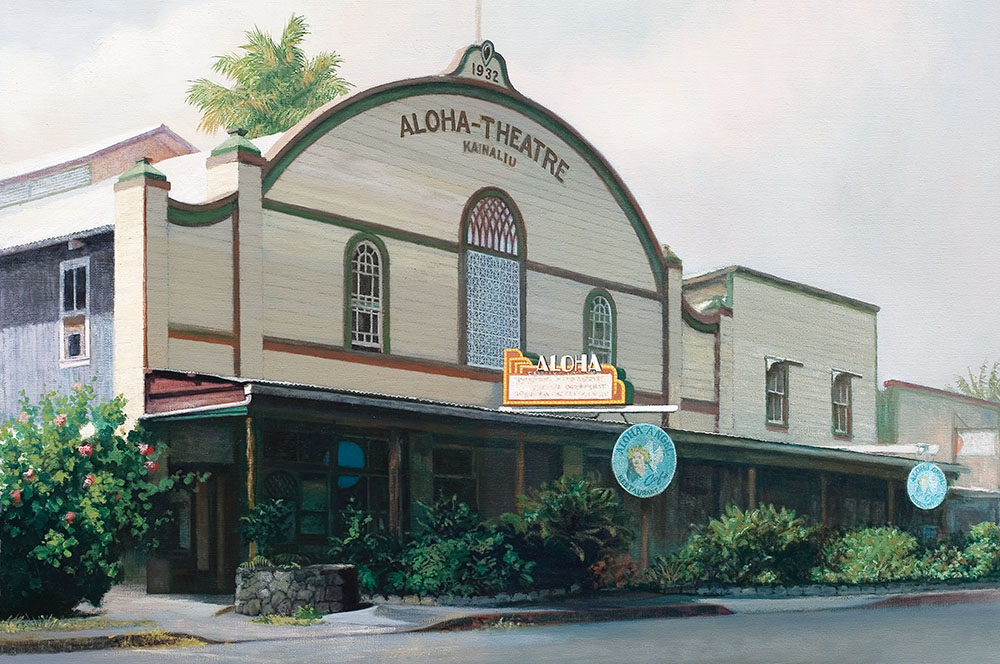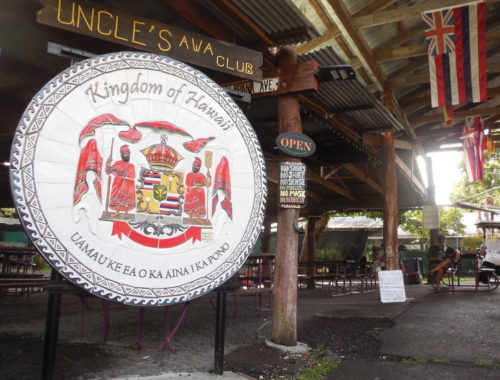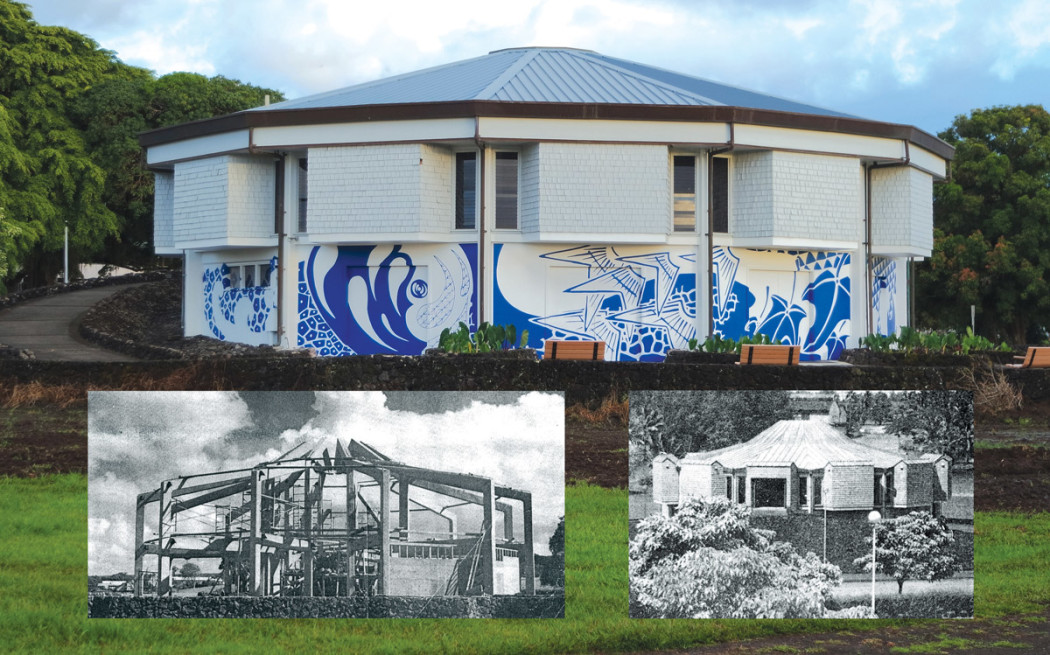
50 Years of Inspired Art at Hilo’s Wailoa Center
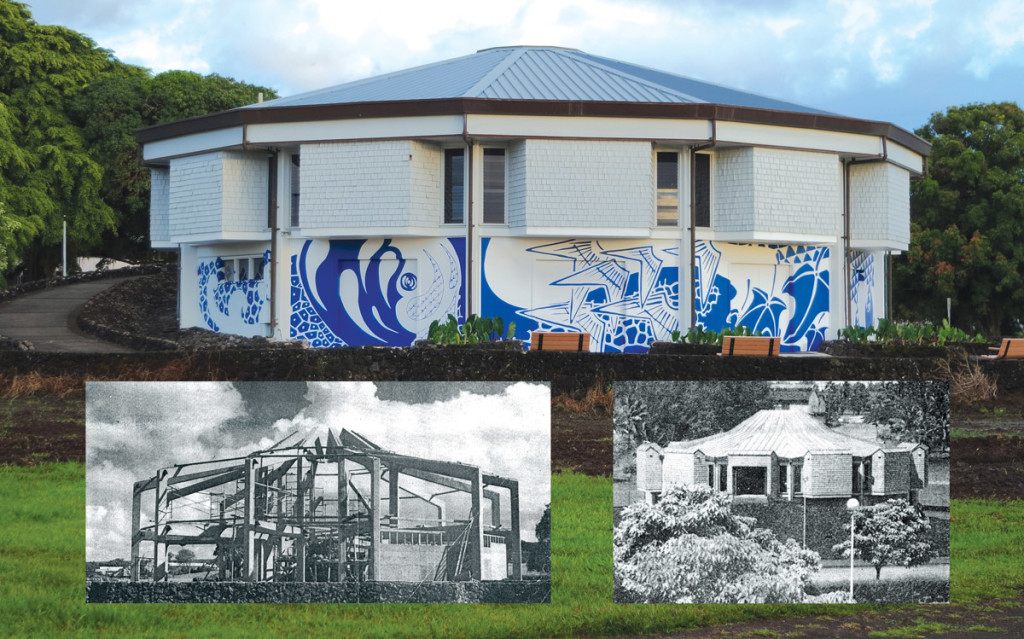
By Leilehua Yuen
Since 1967, the Wailoa Center has graced Pi‘opi‘o, an ‘ili kūpono (chiefly holding place) in the Waiākea ‘ahupua‘a (district) of Hilo. The center was part of an effort to create a green zone and recreation area after Hilo’s Japanese settlement Shinmachi, “New Town,” was destroyed by the 1960 tsunami.
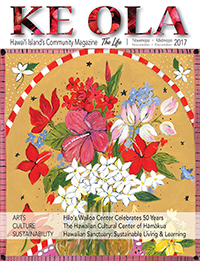
Shortly after, in 1962, the State of Hawai‘i turned this area into a 132 acre green zone, forming the Wailoa River State Recreation Area along Hilo’s bay front. Wailoa Center was created, in addition to a tsunami memorial, veteran’s memorial, and statue of Pai‘ea Kamehameha.
Shinmachi Tsunami Memorial, a wave-shaped lava amphitheater with a ceramic mosaic, is the setting for the entry courtyard, and honors the people of Hawai‘i Island who were lost to both the 1946 and 1960 tsunamis.
The Wailoa Center, was designed by Oda & McCarty Architects and completed in April, 1967. Now a half-century old, it retains the classic 1960s architecture. Then-governor John Burns shepherded the center’s construction as a mahalo (thank you) to Hilo for supporting him, and placed Tadao Okimoto as its first director. The first exhibit was of sterling silver, which ran for four years. That was followed by a kimono exhibit, which ran for almost two years.

When Okimoto was ready to retire from the center, Kathleen “Pudding” Lassiter was asked to apply for the position. By 1999, it was time for some refurbishing. The center needed new paint, inside and out. The asphalt floor was cracked. The storage room was full of unused items, and the office was cramped. Lassiter was given $6,000 for paint. “The whole community pulled together,” she says. George Iranon at Kulani Prison brought 30 inmates to the center, where they worked for three weeks. They cleaned the storeroom and made it into an office, and turned the small office into a gallery. “I had no money to feed them,” Lassiter says. “I went to all the okazuya and each one donated bentos… Safeway and KTA donated watermelons… Pepsi donated sodas… So, they could eat and they had all the soda they wanted for the three weeks.” After their release, several came back to work at the center as volunteers.
Lassiter recruited volunteers from all walks of life, including seniors from the county Retired and Senior Volunteer Program. Her oldest volunteer was Caroline Johnson, who began at the center in her 90s. When she was 105, she told Lassiter she would need to retire, as she could no longer hear the phone.
The loving maintenance provided by a variety of entities has kept the building in excellent shape for its age. Throughout the years, local businesses and individuals have lent their time, talent, and other resources to mālama, to care for, the center.

Codie King, the current Wailoa Center director, says, “Without our supportive community, without our volunteers, without individuals who find the value in culture and art, Wailoa Center would not still be here 50 years later. I feel the momentum growing for Wailoa Center to continue well into the future by celebrating our community’s shared diversity, ideas and perspectives. We will grow, side by side, with our many cultures, with our varied beliefs in our delicate environment, hopefully to perpetuate a meaningful, positive lifestyle we can share with the world.”
The most recent refurbishment includes a series of murals, by Hawai‘i Island artist and educator Emily Leucht, which enwrap the building. Each of the mural panels references a different place-based story of Pi‘opi‘o.
Lokelani Brandt, whose master’s thesis is an ethno-historical study of Pi‘opi‘o, uncovered a list of place names recorded in 1925 by Mrs. Ka‘ouli Ka‘ai and documented by Theodore Kelsey. It is these place names that are inspiration for the imagery within the mural. Brandt says, “Recalling the old stories is one part of maintaining a connection to our past. The history and heritage of a place are realized when we retell and internalize its stories. As we move forward and are required to make decisions about how we will utilize a place, knowing the cultural history allows us to make informed decisions that are founded on the generational layering of knowledge and wisdom that are place specific.”
Leucht says, “I hope that the representation of these names in this visual and public manner will encourage our community to question the history of Hilo that they already know, and then to look deeper. I hope to honor those that have come before, and that this peek into the past will give us a path towards the revitalization of Pi‘opi‘o, a central part of Waiākea and Hilo.”

Included in that revitalization of Pi‘opi‘o is an ethnobotanical garden. In traditional Hawaiian thought, plants have a genealogy that connects them to humans. Urbanization and agriculture have removed many native plants from the daily lives of people, severing this connection. The Pi‘opi‘o Ethnobotanical Garden, proposed in March of this year, seeks to honor and renew the connection, and to revitalize the area by providing an interactive garden that features food crops as well as plants for making medicine, lei, dye, and cordage.
The garden is planned to be a community resource of plants high in ethnobotanical importance. As a centrally located space that curates these vital species, the garden will provide a place where the public can interact with these plants, form stronger relationships with them, and practice cultural traditions, all of which will ensure that these “plant people” have a seat at our table for generations to come.
Supporting an ethnobotanical garden, providing space for teaching art, and hosting exhibits throughout the year makes a busy calendar, which is quite a change from the early days of the center when a kimono show once ran for two years. Over the years, exhibits have changed from primarily cultural shows to various art shows and exhibits.
Annual Exhibits
The most widely attended exhibit is the Big Island Woodturners in March. Next year they will be celebrating their 20th Annual Exhibit. Some Hawai‘i Island visitors plan their yearly vacation around this exhibit so they can attend it.

Every April, the guests are delighted to see MAMo—the Maoli Art Month Show. Features Native Hawaiian Artists on the Big Island in conjunction with the Merrie Monarch Festival.
Another very popular show is the Abstract Only show in August, which has been a staple for 14 years. The State Foundation on Culture and Arts regularly schedules a review of the exhibit for possible Acquisition Awards.
For two years now, the center has featured a show called Contemporary Crafts which showcases local talent of craftsmen using the media of glass, ceramics, wood, metal fiber and mixed media.
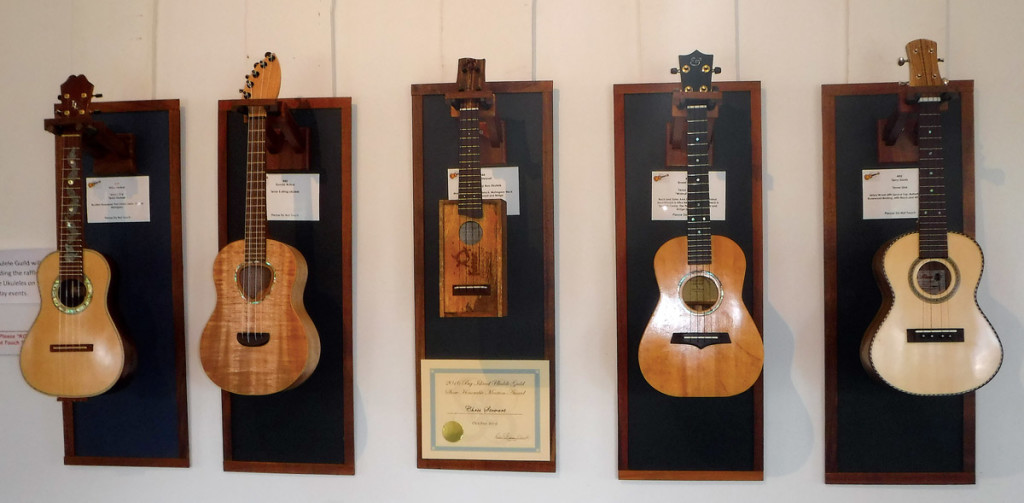
In October, Wailoa Center welcomes the Big Island Ukulele Guild Annual Exhibit in conjunction with the Big Island Woodworkers Invitational. Two invited artists are chosen each year to enhance the exhibits using two-dimensional artwork for the walls and three-dimensional artwork, usually a ceramic or glass, to accent the wood.
During the current season, Wailoa Center is featuring a Hawai‘i Nei exhibit, celebrating Hawai‘i’s native species. This year it runs from November 3 to December 13.
Hawai‘i Island Art Alliance, a local nonprofit group, has emerged in the last few years to become a main support of Wailoa Center and art in our island-wide community. They sponsor and support four juried exhibits a year at Wailoa Center. Many of the other exhibits have ties with various community groups, other art organizations, and the University of Hawai‘i at Hilo.
The Wailoa Center is part of the Department of Land and Natural Resources, Division of State Parks, and is open to the public Monday through Friday from 8:30am to 4:30pm free of charge. ❖
All photos courtesy of Wailoa Center.
For more information about the Wailoa Center: wailoacenter.com.
